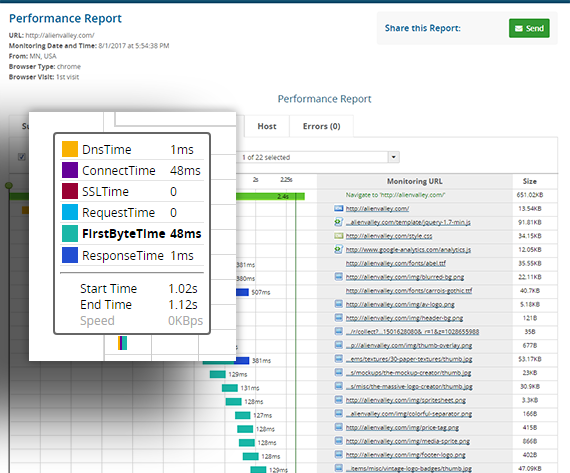Website Speed Testing Secrets Revealed
You know that website speed has an impact on your company’s success. Site visitors have a limited amount of patience to spend on waiting for your site to load. But you can’t fix any issues affecting your website speed if you don’t know that you have them, or what’s causing them.
That means you need to perform several types of website speed testing on a regular basis.

Free Website Speed Testing
To test your website speed sporadically, you can get away with using a free test like Dotcom-Monitor’s Website Speed Test. This free tool will test a page on your site and return a report with charts and graphs that help you identify the bottlenecks that are slowing down your site.
Even more, Dotcom-Monitor’s Website Speed Test can test your site’s speed from locations all over the world. This reflects the experience of users all over the globe, giving you a more detailed and accurate picture.
Monitor Website Speed
Your website speed can be affected by a variety of factors, some of which can arise at a moment’s notice. Without constant monitoring of your site’s speed, you could be losing customers without even knowing. That’s important enough that you should find room in the budget for a monitoring tool. Any website speed monitoring tool should be able to send you SMS, e-mail and phone alerts whenever your website slows down. Checkout BrowserView for automating your website speed monitoring. Even better – try it free for 30 days.
Load Testing
The point of load testing is to see if your website speed is affected by an increase in visitors. If your site loads more slowly on big shopping days like Black Friday or Cyber Monday, you’re going to lose customers to your competitors. It’s simply not good enough to assume that your site will load quickly for many more visitors than usual just because it works well in other types of website speed testing. You should perform load testing periodically and whenever you launch a new feature.
Between hardware and software expenses, load testing used to be so cost-prohibitive that far too many companies skipped it and hoped for the best. Thanks to affordable, cloud-based load testing solutions, you only have to pay for server time while you’re performing a load test.
Monitoring Server Ping Time
Server response time can have a big effect on website speed. According to Google, “You should reduce your server response time under 200ms.” A Traceroute and Ping Tool can monitor and test continuously to let you know when things slow down.
Your Site’s Design May be at Fault
This is one of the biggest website speed testing secrets because everyone assumes that server response time is at fault for any slowdown. It’s definitely a factor, but if your site isn’t designed to load quickly, adding extra servers will only help so much.
A site redesign is a huge effort, so you probably won’t get buy-in for a complete overhaul to speed up your site. But you can make sure website speed is considered during the design of new features. When there is a full site redesign, make sure to get a seat at the table so that page load time will be considered at the earliest stage of the project.
The fewer elements a page has, the more quickly it will load. Page design should use images and plug ins only when absolutely necessary. Fortunately, minimalist design tends to make a site more visually appealing so it should be easy to get business stakeholders on board.
Conclusion
Having a website that loads quickly gives you an advantage over your competitors who don’t know all the secrets of website speed testing. There’s so much value in speed testing efforts, that skimping on this type of testing will only end up hurting your site’s ranking and overall quality.


